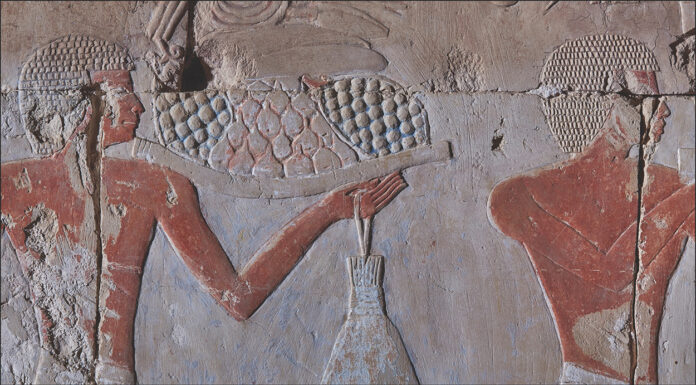New research reveals that ancient Egyptian reliefs were carved by artists of varying skill levels, with apprentices studying under master sculptors who corrected their mistakes as they practiced different techniques. The study, published today in Antiquity, focuses on the production process for a set of 3,500-year-old reliefs at the Chapel of Hatshepsut in Thebes, which was constructed during the 15th century BCE.
Scholars have long believed that apprentices learned their craft before they were allowed to carve reliefs for rooms like this one. But Anastasiia Stupko-Lubczynska, the author of the new study, found that apprentices absorbed the painting process as they went along, working alongside masters as they realized major works.
In an interview, Stupko-Lubczynska said she had come to that conclusion by attempting to retrace the way the reliefs were made in the Chapel of Hatshepsut. “While documenting the reliefs in the Chapel, drawing the preserved images line by line, I felt like I was sitting beside an ancient sculptor on a scaffolding,” she said.
The chapel is the largest room in the Temple of Hatshepsut. It features two reliefs dedicated to the female pharaoh Hatshepsut, who ruled Ancient Egypt from 1473 BCE to 1458 BCE. Both of these massive reliefs—whose images mirror each other—are over 40 feet long, and they are situated across parallel walls. In them, hundreds of figures are shown carrying offerings to Hatshepsut on her throne. Built for Hatshepsut’s mortuary cult, the room was made using limestone blocks that were then decorated with raised painted reliefs.
Relief-making in ancient Egypt was a seven-step process that involved a preliminary sketch and the application of a square grid. Evidence of these steps can still be found in some of the finished works at the Chapel. That makes these reliefs rare, since most reliefs were executed so that the process leading up to the final result wasn’t left visible.
Archaeologists accept that the process also involved smoothing the wall and plastering over it, and then dividing the space into sections and applying the grid. A preliminary sketch in red paint was copied from a prepared drawing, with a master artist correcting any mistakes and adding more detail in black paint. Any accompanying text was then inscribed, and sculptors began their work following the outlines of the sketch. The finished relief was finally whitewashed and painted.
Stupko-Lubczynska’s investigation revealed that certain parts of a relief were typically done by amateurs. Apprentices, who often had less experience, worked on less complex areas like torsos, arms, and legs, while master artists took care of complicated elements, such as faces.
Experts have long believed that limestone flakes acted like something akin to sketchbooks for apprentices. Stupko-Lubczynska’s new research shows that sculptors also learned by attempting detailed carvings on important large-scale projects such as sacred temples. That teaching process can be seen in the rendering of wigs, which were particularly time-consuming to carve. Because of this, apprentices and masters worked together to render them, turning the task into a teaching opportunity.
Research also revealed that a different crew worked on each of the mirrored reliefs, producing slightly different results. For example, one jug is depicted as a clay container on a rope, while on the opposite wall, a metal container is shown.
In the reliefs, Stupko-Lubczynska said it is possible to say where a “master demonstrated his virtuosity” and “where a beginner was trying hard to finish a detail which was too complicated.”
























